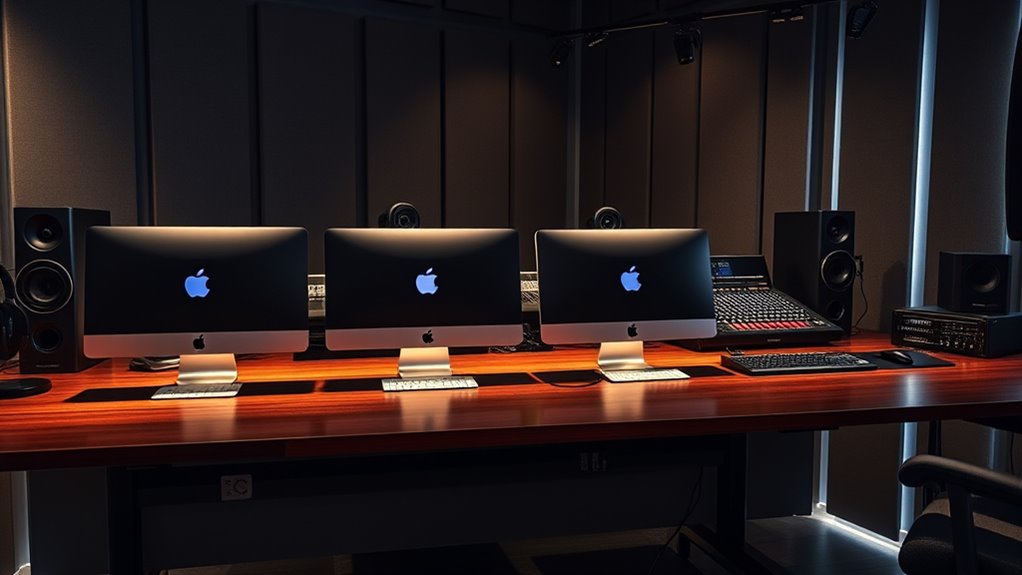If you’re looking for the best Mac Studio models for audio production in 2025, I recommend considering the M4 and M4 Pro versions. The M4 models offer a 10-core CPU and 10-core GPU, while the M4 Pro provides a 12-core CPU and 16-core GPU for demanding projects. They also support ample memory and storage, plus multiple displays, making them perfect for professional audio work. If you want to find out which suits your setup best, keep exploring the options available.
Key Takeaways
- Prioritize Mac Studio models with M4 Pro chips for higher processing power and better multitasking in demanding audio workflows.
- Opt for configurations with at least 32GB RAM and 1TB+ storage to handle large projects and sample libraries efficiently.
- Ensure the model supports multiple high-resolution displays and extensive connectivity options for seamless studio integration.
- Consider models with advanced cooling and vibration dampening features for quiet operation during recording and mixing.
- Choose Mac Studio variants that offer future-proofing features like higher RAM, SSD capacity, and multiple Thunderbolt 4/USB-C ports.
Apple 2024 Mac mini Desktop Computer with M4 Chip
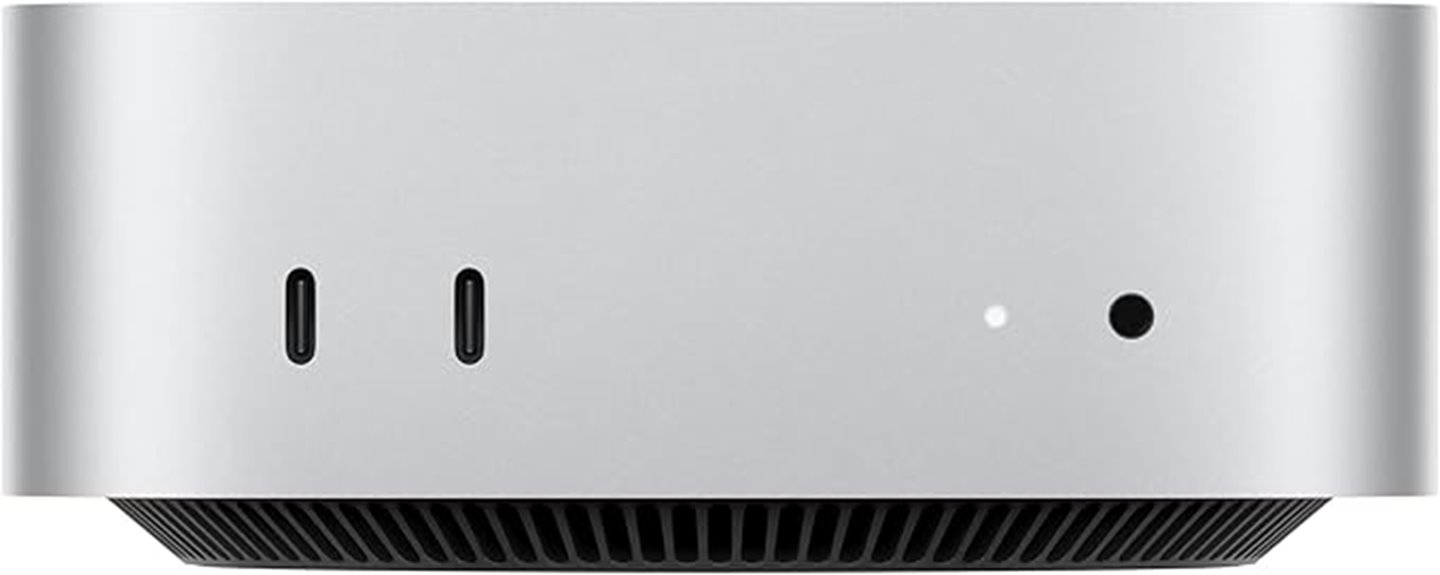
The Apple 2024 Mac mini with the M4 chip is an excellent choice for audio producers who need a compact yet powerful workstation. Its sleek, 5×5-inch aluminum design fits easily next to monitors, making it ideal for limited space. Despite its small size, it packs a 10-core CPU, a 10-core GPU, and 16GB of unified memory, delivering impressive speed and efficiency. It supports up to three high-resolution displays and offers robust connectivity with Thunderbolt 4, HDMI, Ethernet, and USB-C ports. Quiet and energy-efficient, this Mac mini handles demanding audio tasks smoothly, making it perfect for those who want powerful performance in a tiny footprint.
Best For: audio producers and creative professionals seeking a compact, high-performance desktop with advanced connectivity and seamless integration within the Apple ecosystem.
Pros:
- Ultra-compact, sleek design fits easily into limited workspace environments
- Powerful M4 chip with a 10-core CPU and GPU delivers fast, efficient performance for demanding audio and creative tasks
- Supports multiple high-resolution displays and comprehensive port options including Thunderbolt 4 and HDMI
Cons:
- No USB-A ports, requiring adapters for legacy peripherals
- Power button placement at the bottom may be less convenient for some users
- Base memory of 16GB may be limited for intensive multitasking or large projects
Apple 2024 Mac mini Desktop Computer with M4 Chip
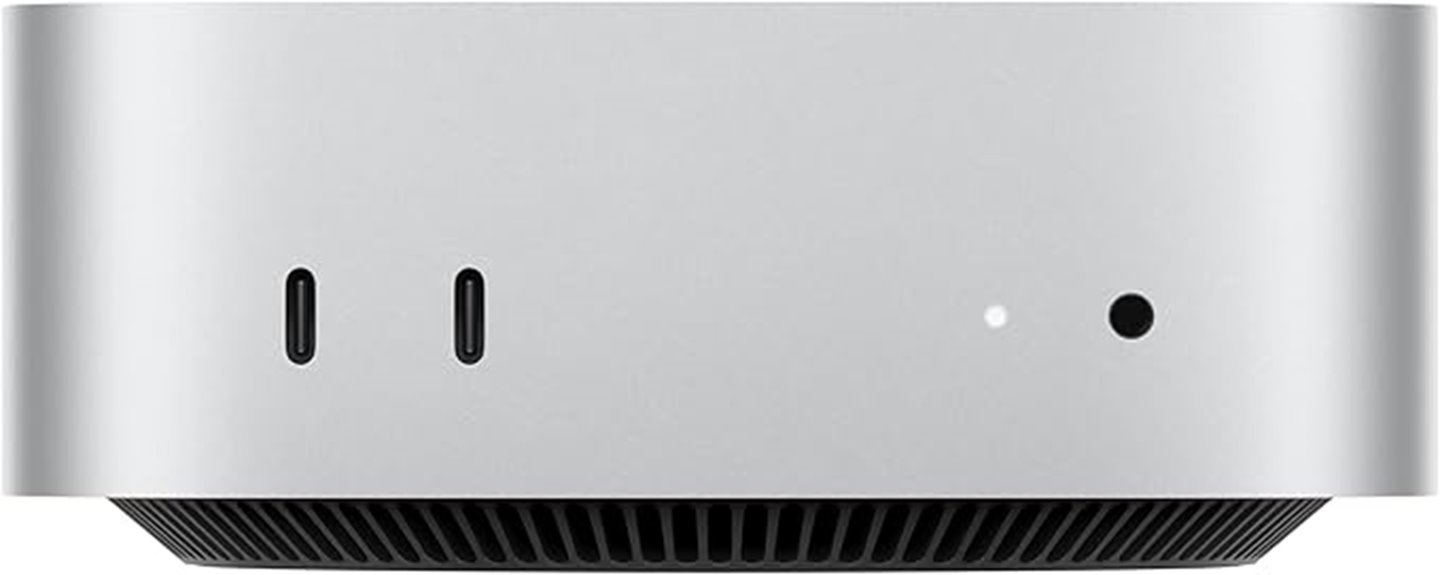
If you’re looking for a compact yet powerful desktop to handle demanding audio production tasks, the Apple 2024 Mac mini with M4 chip stands out. Its small 5×5-inch design packs a 10-core CPU, 10-core GPU, and a 16-core Neural Engine, delivering notable performance gains. With 16GB of unified memory and up to 2TB SSD storage, it handles large audio projects with ease. Extensive connectivity options, including Thunderbolt 4, HDMI, and multiple USB-C ports, support multiple peripherals and displays. Its quiet operation and energy efficiency make it ideal for studio or home environments. Despite the absence of USB-A ports, the Mac mini offers a sleek, capable solution for creative workflows.
Best For: creative professionals and audio producers seeking a compact, high-performance desktop capable of handling demanding multimedia tasks with extensive connectivity options.
Pros:
- Powerful performance with the M4 chip, including a 10-core CPU and GPU for demanding workflows
- Compact, stylish design suitable for space-constrained environments
- Quiet operation and energy efficiency ideal for studio or home use
Cons:
- No USB-A ports, requiring adapters for legacy peripherals
- Base model memory (16GB) may limit extremely intensive multitasking or large projects
- Power button placement may be less intuitive for some users
Apple 2024 Mac mini Desktop Computer with M4 Chip

For audio producers seeking a compact yet powerful desktop, the Apple 2024 Mac mini with M4 chip stands out as an excellent choice. Its sleek aluminum design measures just 5 by 5 inches and weighs only 1.5 pounds, making it highly portable and space-efficient. Powered by the M4 chip, it offers a 20% CPU boost, improved GPU performance, and a 35% increase in AI capabilities with a 16-core Neural Engine. It supports up to three displays, handles demanding audio and video tasks, and features a range of ports including Thunderbolt 4 and HDMI. This compact powerhouse seamlessly integrates with Apple’s ecosystem, making it ideal for creative workflows.
Best For: audio producers and creative professionals seeking a compact, high-performance desktop with seamless Apple ecosystem integration.
Pros:
- Compact, sleek aluminum design that fits easily in tight spaces and is highly portable
- Powerful M4 chip with significant CPU, GPU, and AI performance improvements
- Supports up to three external displays, ideal for multitasking and creative workflows
Cons:
- Removal of USB-A ports requires adapters for some peripherals
- Power button placement at the bottom may be less intuitive for users
- Limited base memory (24GB), which could restrict demanding audio and video workflows
Apple 2024 Mac mini Desktop Computer with M4 Pro chip
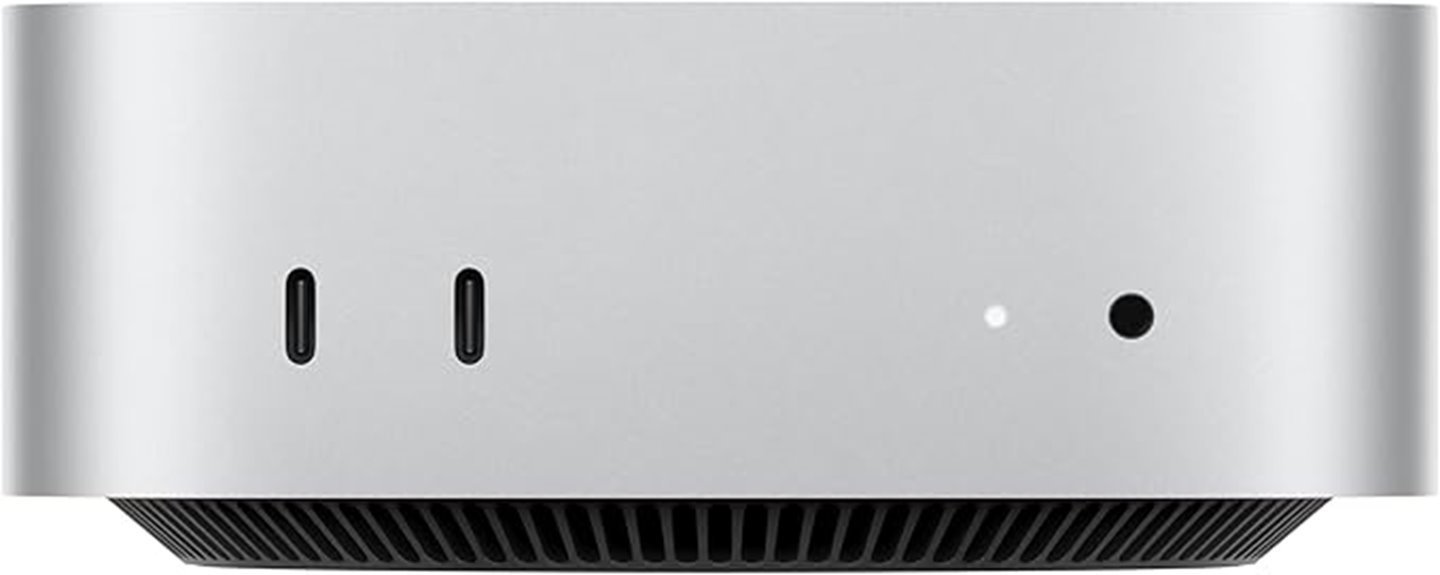
Designed for demanding creative tasks, the Apple 2024 Mac mini with the M4 Pro chip delivers impressive power in a compact form factor. Measuring just 5 inches square and weighing 1.5 pounds, it fits easily next to any monitor and offers a sleek aluminum finish. Despite its small size, it boasts a 12-core CPU, 16-core GPU, and 16-core Neural Engine, providing a 20% CPU boost and 35% AI performance increase over the M3. With up to 64GB of memory and 8TB storage, plus versatile ports—including Thunderbolt 4, HDMI, and Ethernet—it handles intensive audio production and multitasking effortlessly.
Best For: creative professionals and power users seeking a compact, high-performance desktop capable of handling demanding tasks like video editing, 3D rendering, and multitasking.
Pros:
- Compact and lightweight design fits seamlessly next to monitors and in small spaces
- Powerful M4 Pro chip with significant CPU, GPU, and AI performance improvements
- Versatile connectivity including Thunderbolt 4, HDMI, and up to 64GB RAM and 8TB storage
Cons:
- Missing USB-A ports may require adapters for some peripherals
- Power button placement on the bottom can be less intuitive to access
- Base memory starting at 24GB might be limiting for intensive workflows
Factors to Consider When Choosing a Mac Studio for Audio Production
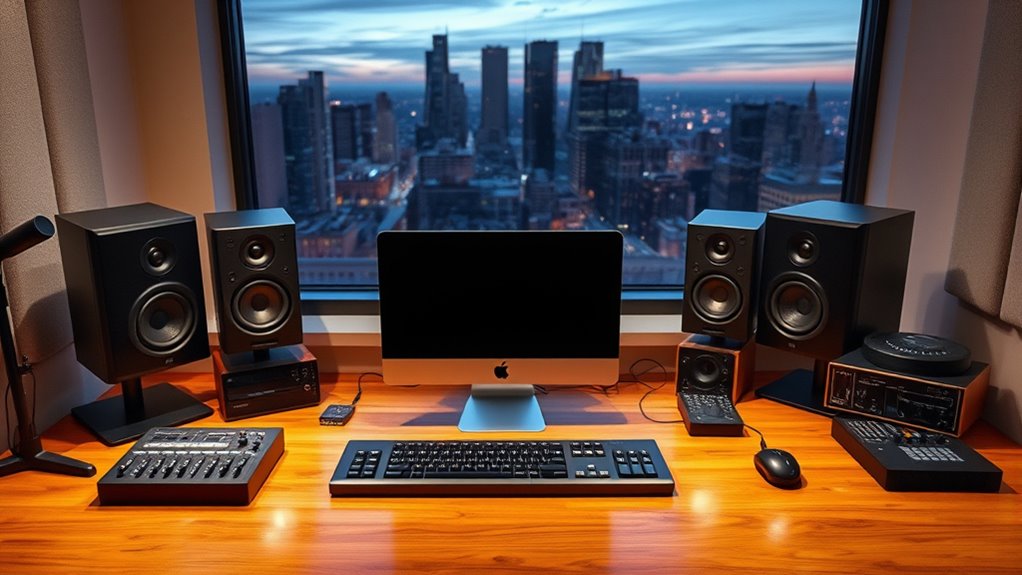
When choosing a Mac Studio for audio production, I focus on several key factors. I consider my processing power needs, compatibility with my audio interface, and how much storage and memory I require. These points help guarantee I get a setup that’s powerful, reliable, and tailored to my workflow.
Processing Power Needs
Choosing the right Mac Studio for audio production hinges on understanding your processing power needs, as this directly impacts your ability to work efficiently and without latency. High-quality audio production demands robust processing to handle real-time effects, mixing, and mastering smoothly. Multi-track sessions with high-resolution audio and multiple virtual instruments require a powerful CPU with enough cores and speed to keep workflow seamless. Hardware acceleration for plugins and DAWs also benefits from a strong CPU and GPU, reducing rendering times. For advanced tasks like spectral editing or binaural mixing, higher processing power guarantees you can perform complex tasks in real time. Ultimately, selecting a Mac Studio with ample CPU and RAM capacity guarantees you can handle large sessions and demanding projects confidently.
Audio Interface Compatibility
Selecting the right Mac Studio for audio production means guaranteeing it can seamlessly connect with your audio interface. Most professional interfaces rely on Thunderbolt 3 or 4 ports for fast, reliable data transfer, so it’s vital to verify these connections are available. If you’re using USB-C or USB-A interfaces, you’ll want to confirm compatibility or be prepared with adapters, especially since port types may change. Additionally, check if the Mac Studio supports multi-channel audio interfaces for complex recording setups. Compatibility with your specific driver and operating system versions is necessary to ensure smooth operation. Finally, consider the power delivery and bus-powered capabilities when connecting multiple interfaces, as bandwidth limitations could impact performance during demanding sessions.
Storage Capacity Requirements
Having sufficient storage capacity is vital for smooth audio production, as large project files, sample libraries, and backups can quickly fill up your drive. Most workflows require at least 512GB, but professional setups often benefit from 1TB or more to avoid constant data transfers. Upgrading to 2TB or 4TB can future-proof your system, accommodating bigger projects and expanding libraries. Fast SSD storage is essential, as it considerably reduces load times and speeds up access to large files and plugins. When choosing a Mac Studio, I recommend carefully evaluating your current needs and potential growth. Relying on limited storage can become costly or restrictive over time, so it’s wise to select a model with ample capacity upfront, ensuring a seamless and efficient audio production experience.
Connectivity Options
When setting up a Mac Studio for audio production, it’s essential to pay close attention to its connectivity options, as these determine how smoothly your workflow runs. You’ll want enough Thunderbolt 4 or USB-C ports to connect multiple audio interfaces, MIDI controllers, and external storage without hassle. If you incorporate video elements, check for HDMI or additional video outputs to streamline your setup. Also, verify support for high-speed USB-A ports or plan to use adapters, since some models may lack these connections, which are indispensable for certain gear. Ethernet connectivity—preferably Gigabit or 10Gb—is critical for stable, high-bandwidth transfers of large audio files. Lastly, consider the overall number and variety of ports to future-proof your setup and avoid relying heavily on adapters or hubs.
Memory Configuration
Choosing the right memory configuration for your Mac Studio is vital for smooth audio production, especially as projects become more complex. Higher memory options, like 32GB or 64GB, allow for smoother multitasking and more efficient handling of large audio sample libraries. Upgrading to 24GB or 32GB of unified memory can notably reduce lag during demanding mixing and editing sessions. Sufficient RAM is essential when running multiple audio plugins and virtual instruments simultaneously without performance drops. For intensive workflows, I recommend a minimum of 32GB to future-proof your setup and guarantee maximum performance. The amount of memory directly impacts your ability to work seamlessly with high-resolution audio files and large project files, making it a key factor in selecting the right Mac Studio for serious audio production.
Display Support Features
A key factor in selecting the right Mac Studio for audio production is its display support features, which determine how effectively you can manage multiple high-resolution screens. The Mac Studio supports up to four external displays, including two 6K monitors over Thunderbolt and a 4K display via HDMI, making it ideal for complex workflows. Its advanced features like HDR with Dolby Vision, HDR10+, and HLG ensure excellent color accuracy and high dynamic range, vital for visual clarity alongside audio work. Supporting DisplayPort 1.4 and HDMI 2.0 standards, it can connect to up to 8K monitors at 60Hz. Multiple Thunderbolt 4 and USB-C ports provide flexible, high-speed connections to various displays and peripherals, enhancing productivity and creative precision across all screens.
Noise and Vibration Levels
Minimizing noise and vibration levels is crucial for creating a pristine audio production environment, as even subtle disturbances can interfere with recordings and monitoring. Mac Studio models are engineered with efficient cooling systems that keep fan noise minimal during demanding tasks, helping maintain a quiet workspace. Additionally, vibration dampening features like rubber feet and internal isolators reduce external and internal vibrations that could disrupt sensitive audio equipment. Quiet operation allows for more accurate monitoring and mixing, free from background noise distortion. Selecting a Mac Studio with low noise and vibration levels ensures a stable, acoustically pure environment, which is essential when capturing or editing audio. Overall, these design considerations help maintain clarity and focus, making them imperative factors for any professional audio setup.
Ecosystem Integration
When selecting a Mac Studio for audio production, understanding how well it integrates with the Apple ecosystem can substantially boost your workflow. Seamless synchronization of files, projects, and settings across devices means you can start editing on an iPad or iPhone and pick up right where you left off on your Mac Studio. Features like AirDrop and iPhone mirroring allow quick transfer of recordings and samples without manual hassle. Continuity tools like Handoff make switching between devices smooth, saving time. Compatibility with Apple-specific apps like Logic Pro and GarageBand ensures optimized performance, while deep iCloud integration provides automatic backups and easy access to assets anywhere. Overall, strong ecosystem integration keeps your workflow efficient, flexible, and collaborative, making your setup more powerful and intuitive for audio production.
Frequently Asked Questions
How Does Thermal Management Impact Audio Performance During Extended Sessions?
Thermal management is essential for maintaining audio performance during long sessions because it prevents overheating, which can cause the Mac Studio to slow down or throttle its processor. When the device stays cool, I notice smoother editing, faster rendering, and fewer crashes. Good airflow and heat dissipation ensure my creative work isn’t interrupted by hardware issues, allowing me to focus on producing high-quality audio without worrying about thermal limitations.
Can Third-Party Peripherals Enhance Mac Studio Audio Production Capabilities?
Absolutely, third-party peripherals can be a game-changer for Mac Studio audio production. They often offer specialized features like superior audio interfaces, MIDI controllers, or enhanced monitors that Apple’s built-in options can’t match. Think of it as adding tools to your toolbox—each one helps you craft better sound. Just make sure they’re compatible and high-quality so you don’t end up chasing your tail.
What Are the Best Storage Options for Large Audio Projects on Mac Studio?
For large audio projects on my Mac Studio, I prefer external SSDs like the Samsung T7 or SanDisk Extreme Pro because they’re fast and reliable. I also use Thunderbolt 3 or 4 drives for even quicker data transfer. Internal storage is great, but for heavy projects, expanding with external drives gives me flexibility and peace of mind, ensuring I never run out of space or experience lag during critical sessions.
How Does Network Connectivity Influence Real-Time Audio Collaboration?
Network connectivity plays a vital role in real-time audio collaboration. When my internet is fast and stable, I experience seamless streaming, quick file sharing, and smooth communication with collaborators worldwide. But if my connection drops or slows down, it causes lag, dropouts, and frustrating delays. So, for exceptional collaboration, I always make certain my network is reliable, with high bandwidth and low latency, to keep everything running smoothly.
Are There Specific Software Optimizations for Mac Studio in Audio Production?
Yes, there are specific software optimizations for Mac Studio in audio production. I’ve noticed that many DAWs like Logic Pro, Ableton Live, and Pro Tools are optimized for Apple Silicon, providing faster processing and smoother workflows. Additionally, macOS updates often include audio enhancements that reduce latency and improve stability. I recommend keeping your software and system up to date to get the best performance and avoid compatibility issues.
Conclusion
Choosing the right Mac Studio for audio production is like assembling a symphony — each piece must harmonize perfectly. Whether you opt for the power of the M4 or the versatility of the M4 Pro chip, you’re investing in a tool that transforms your creative ideas into reality. Remember, the best Mac Studio is the one that resonates with your workflow and helps you hit all the right notes. Your perfect setup awaits!

